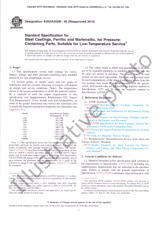We need your consent to use the individual data so that you can see information about your interests, among other things. Click "OK" to give your consent.
ASTM C912-17(2022)
Standard Practice for Designing a Process for Cleaning Technical Glasses
Translate name
STANDARD published on 1.7.2022
The information about the standard:
Designation standards: ASTM C912-17(2022)
Publication date standards: 1.7.2022
SKU: NS-1068719
The number of pages: 7
Approximate weight : 21 g (0.05 lbs)
Country: American technical standard
Category: Technical standards ASTM
The category - similar standards:
Annotation of standard text ASTM C912-17(2022) :
Keywords:
cleaning, glass, solubility, solvents, technical ,, ICS Number Code 81.040.01 (Glass in general)
Additional information
| Significance and Use |
|
3.1?Many of the low-silica technical glasses which contain soluble or reactive oxides require processing or involve applications that require cleaning. Very often these cleaning procedures have evolved over several decades and are considered an art. They usually contain numerous steps, some of questionable validity. It is the premise of this practice that cleaning glass can be more scientific. Design of a cleaning procedure should involve (1.1?This practice covers information that will permit design of a rational cleaning procedure that can be used with a glass that is somewhat soluble in many aqueous chemical solutions. Typically, this type of glass is used in applications such as optical ware, glass-to-metal seals, low dielectric loss products, glass fibers, infrared transmitting products, and products resistant to metallic vapors. 1.2?In most cases, this type of glass contains high concentrations of oxides that tend to react with a number of aqueous chemicals. Such oxides include B2O3, Al2O3, R2O, RO, La2O3, ZnO, PbO, P2O5, and Fe2O3. The more conventional high-silica glasses are usually more chemically resistant, but the cleaning principles outlined here also apply to them. 1.3?This standard does not purport to address all of the safety concerns, if any, associated with its use. It is the responsibility of the user of this standard to establish appropriate safety, health, and environmental practices and determine the applicability of regulatory limitations prior to use. 1.4?This international standard was developed in accordance with internationally recognized principles on standardization established in the Decision on Principles for the Development of International Standards, Guides and Recommendations issued by the World Trade Organization Technical Barriers to Trade (TBT) Committee. |
We recommend:
Technical standards updating
Do you want to make sure you use only the valid technical standards?
We can offer you a solution which will provide you a monthly overview concerning the updating of standards which you use.
Would you like to know more? Look at this page.




 Cookies
Cookies
